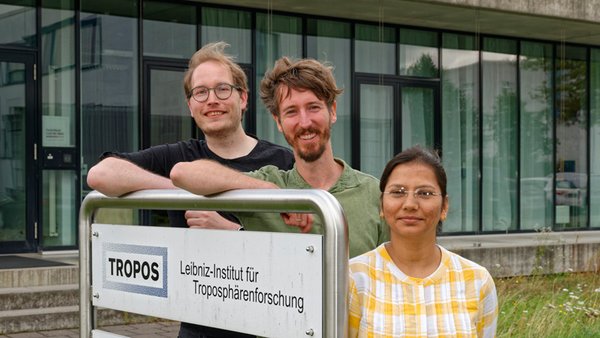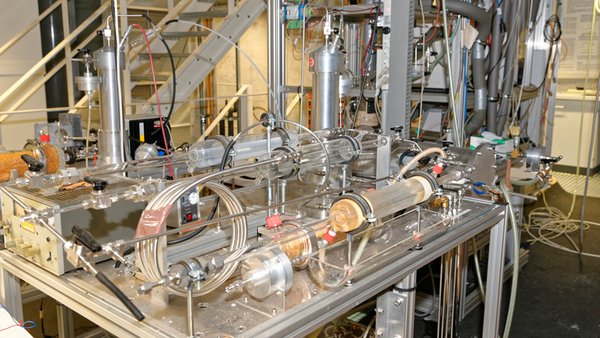OLALA - A new laboratory for atmospheric research
Leipzig, 26.09.2023
Optical studies on desert dust for "sharper" satellite images
Leipzig. In September, a new research group begins its work in Leipzig at the Leibniz Institute for Tropospheric Research (TROPOS): The junior research group led by Dr. Moritz Haarig aims to understand the influence of the complex shape of mineral dust particles on the scattering of light in order to better quantify the impact of mineral dust on weather and climate.
"OLALA" (Optical Lab for Lidar Applications) is supported by the Leibniz Association within the framework of the Leibniz Competition with almost one million euros for the next 5 years. With the Leibniz Junior Research Groups, the Leibniz Association enables excellent postdocs to set up their own junior research group at a Leibniz Institute in order to realise their own research projects and further establish themselves in their respective research field.
Every year, many tonnes of mineral dust are whirled up in the great deserts of the Earth, a significant part of which is transported in the atmosphere far beyond the deserts, for example from the Sahara to Central Europe. In the atmosphere, the dust particles then influence cloud and precipitation formation, the Earth's radiation budget and human health - even far away from the source regions. Remote sensing with the lidar technology enables height-resolved data on mineral dust in the atmosphere and thus represent an important source of information for researchers. Lidar stands for "light detection and ranging" and is a remote sensing method related to radar: Lidar systems emit short laser pulses and then measure the light scattered back from the atmosphere. The distance to the location of the scattering is calculated from the transit time of the signals and the speed of light. TROPOS operates such lidar systems in Leipzig, and close to the dust sources in Tajikistan, Israel, on Cyprus and the Cape Verde Islands in the Atlantic as well as onboard of research vessels in order to better understand the dust transport. In the near future, there will be another lidar instrument in space that will provide global observations: The European Space Agency ESA is preparing the EarthCARE satellite mission, which is scheduled to launch in spring 2024 and in which TROPOS researchers are involved.
However, remote sensing of mineral dust faces the challenge that, on closer inspection, these particles are characterised by a complex and irregular shape. This shape determines the scattering properties and thus the measurement results of remote sensing. At this point the research group wants to start and set up a new laboratory in Leipzig to study mineral dust particles, the Optical Lab for Lidar Applications OLALA. Dr. Moritz Haarig, together with Dr. Markus Hartmann, the PhD student Esha Semwal and another PhD student, will bring a wide variety of mineral dust particles from the Earth's deserts to Leipzig in order to examine them more closely. It requires a complex optical setup and careful preparation of the dust samples. The group can draw on existing expertise at the Leibniz Institute for Tropospheric Research, such as the freezing experiments with dust particles in the cloud laboratory or the development of optical systems such as lidar devices. The group will closely collaborate with experts at Technical University of Darmstadt, Germany, the universities of Lyon and Lille, France, and the University of Wyoming, USA. The big goal is to use the knowledge gained in the laboratory to better describe the irregular shape of the dust particles in optical models in order to obtain more information from measurements with remote sensing. The size and number concentration of dust particles could thus be better determined even from space. The Leibniz junior research group will draw the bow from field observations near deserts to laboratory studies and particle modelling to better quantify the contribution of dust in global observations from the ground and from space.
Further information:
Optical Lab for Lidar Applications (OLALA)
Projects funded in the Leibniz Competition: Leibniz Junior Research Groups (funding 2023):
https://www.leibniz-gemeinschaft.de/en/research/leibniz-competition/funded-projects
Leibniz-Junior Research Groups
https://www.leibniz-gemeinschaft.de/en/research/leibniz-competition/leibniz-junior-research-groups
Leibniz strengthens dust research in Leipzig: a new working group on modelling and remote sensing of mineral dust in the atmosphere (Press release, 22 Jan 2015):
Aerosols and clouds – process studies on small spatial and temporal scales at TROPOS:
TROPOS Remote Sensing: Own developments: Polly
EarthCARE (Cloud, Aerosol and Radiation Explorer) mission:
https://earth.esa.int/eogateway/missions/earthcare
Media contacts:
Dr. Moritz Haarig,
Research Scientists, Department Remote Sensing, Leibniz Institute for Tropospheric Research (TROPOS), Leipzig
Tel. +49-341-2717-7188
https://www.tropos.de/en/institute/about-us/employees/moritz-haarig
and
Dr. Ulla Wandinger,
Deputy Head & Senior Scientist, Department Remote Sensing, Leibniz Institute for Tropospheric Research (TROPOS), Leipzig
Tel. +49-341-2717-7082
https://www.tropos.de/en/institute/about-us/employees/ulla-wandinger
or
Tilo Arnhold, TROPOS Public Relations
Tel. +49 341 2717-7189
http://www.tropos.de/aktuelles/pressemitteilungen/
The Leibniz Institute for Tropospheric Research (TROPOS) is a member of the Leibniz Association, which connects 97 independent research institutions that range in focus from the natural, engineering and environmental sciences via economics, spatial and social sciences to the humanities. Leibniz Institutes address issues of social, economic and ecological relevance. They conduct knowledge-driven and applied basic research, maintain scientific infrastructure and provide research-based services.
The Leibniz Association identifies focus areas for knowledge transfer to policy-makers, academia, business and the public. Leibniz institutions collaborate intensively with universities – in the form of “Leibniz ScienceCampi” (thematic partnerships between university and non-university research institutes), for example – as well as with industry and other partners at home and abroad.
They are subject to an independent evaluation procedure that is unparalleled in its transparency. Due to the importance of the institutions for the country as a whole, they are funded jointly by the Federation and the Länder, employing some 20,500 individuals, including 11,500 researchers.
The entire budget of all the institutes is approximately 2 billion euros. They are financed jointly by the Federal Government and the Länder. The basic funding of the Leibniz Institute for Tropospheric Research (TROPOS) is therefore financed by the Federal Ministry of Education and Research (BMBF) and the Saxon State Ministry of Science and the Arts (SMWK). The Institute is co-financed with tax revenues on the basis of the budget approved by the Saxon State Parliament.
www.leibniz-gemeinschaft.de/en/home/


